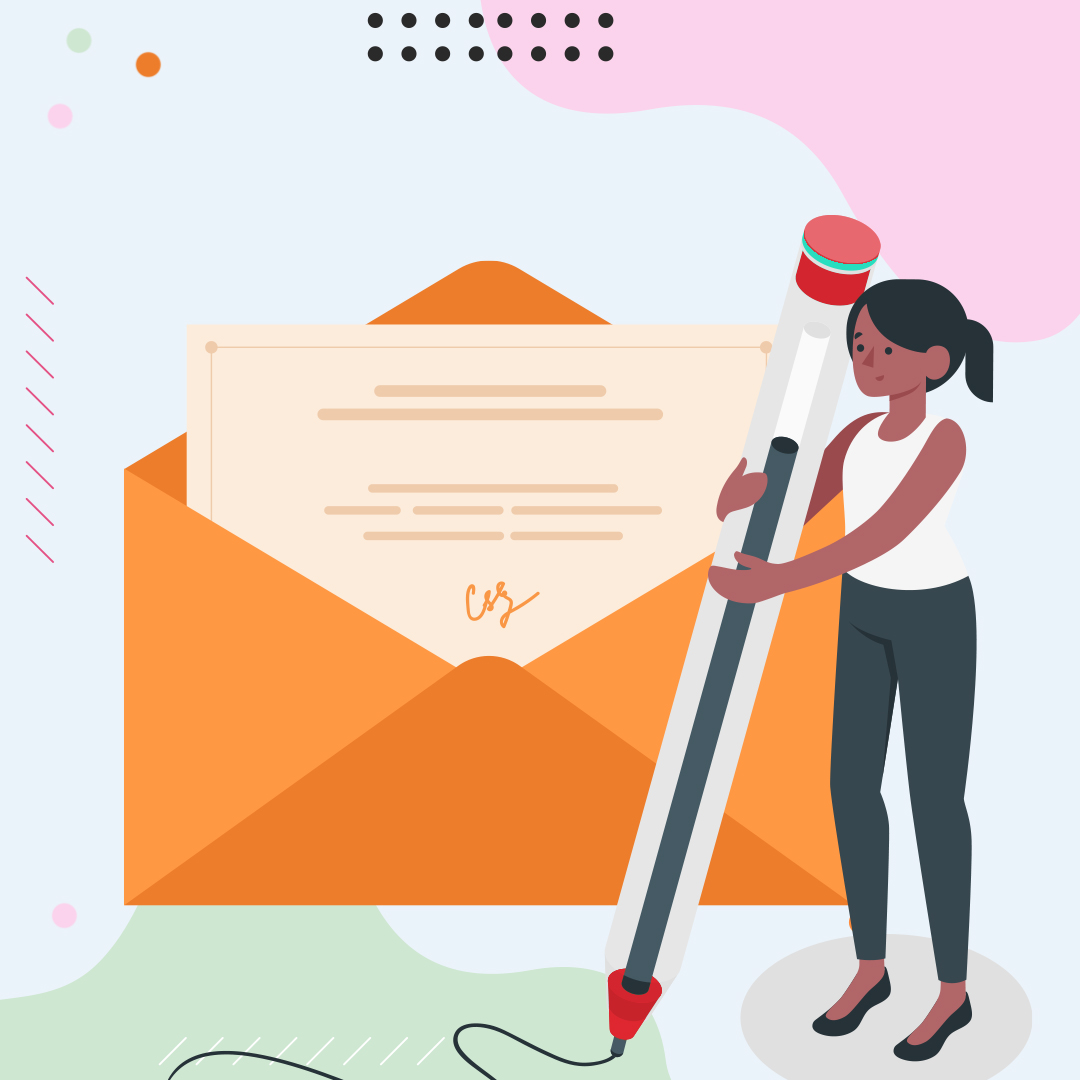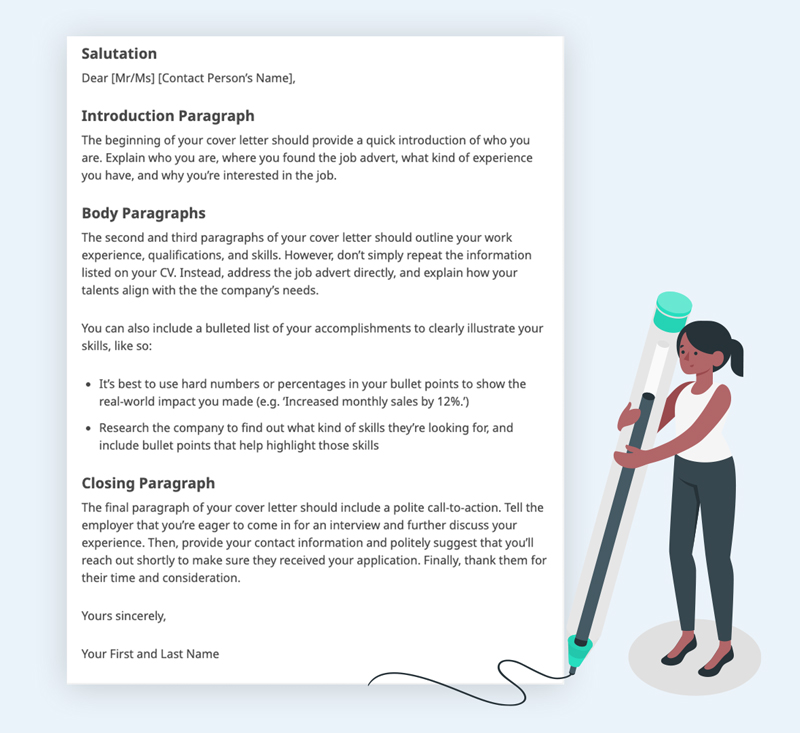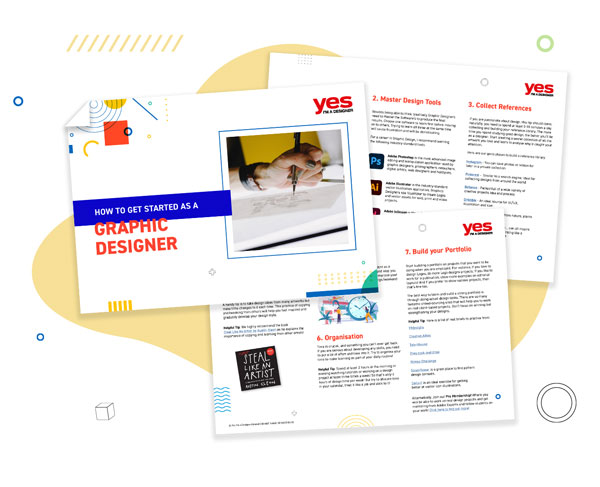If you're looking for a full-time job in graphic design or just a way to make some extra money from your graphic design skills, it's important to send a well-crafted cover letter with your resume. Your cover letter is your opportunity to show employers that you’re the perfect candidate for the job!

So, whether you're just getting started as a graphic designer or have many years of experience under your belt, learning how to structure a solid graphic design cover letter could be the difference you need to stand out from other job candidates and get that interview!
Why is it important to structure your cover letter correctly?
A cover letter is your chance to show off your skills and experience, and explain why you're the best person for the job. But without a clear structure, a busy hiring manager may overlook essential information and move on to the next job application if they don’t find your key skills and qualifications easily.
To increase your chances of landing an interview and make sure your as a graphic designer shines through, here’s how to structure your cover letter clearly:1. Include your contact information in your header
- name
- email address
- phone number
- online profile (LinkedIn, online portfolio, personal website)
This way, the employer can easily get in touch with you when they want to invite you to an interview.
2. Add the company and hiring manager's information
Next, under the header, add the date, the hiring manager's information, and the company address in the following order:
- today's date
- hiring manager’s name
- hiring manager’s phone number
- company address
- hiring manager’s email address
3. Open with an appropriate greeting
If you know the name of the hiring manager, address them by name in your cover letter. Taking the time to find out who to address and how to address them appropriately will make a positive first impression on the hiring manager.
If you're not sure who will be reading your letter, you can address your cover letter to the department you’re interested in or simply write “Dear Hiring Manager”.

4. Write an attention-grabbing opening paragraph
In the opening paragraph of your cover letter, briefly explain why you're writing. Don’t forget to mention the job title you're applying for and where you found out about the job opening. If you were referred by a mutual contact, include this information in your opening paragraph as a referral can give you an advantage over other candidates. Finally, don't forget to show your enthusiasm for the position.
This section of your cover letter should be used to mention your most noteworthy skills or job-specific certifications. Hiring managers are busy people with hundreds of job applications to go through, so make sure you state the right graphic design qualifications at the beginning of your cover letter to capture their attention.
5. Craft a convincing body paragraph
A strong body paragraph should focus on two to four of your most impressive graphic designer qualifications to show why you’re a good match for the job and the company.
6. Include relevant skills and certifications
The body of your cover letter is used to explain why you're qualified for the job. Highlight your most relevant skills by providing specific examples of when you used them in the workplace.
As a graphic designer, you need soft skills such as interpersonal and collaboration skills to effectively communicate ideas and build relationships with colleagues and clients. Other relevant soft skills to include on your cover letter are:
- Problem-solving
- Time management
- Storytelling
- Communication skills
- Creativity
- Collaboration
You'll also need to demonstrate familiarity with different design tools. A great way to showcase your skills is by including courses and certifications in your cover letter. For example, if you're proficient in Adobe Photoshop and Illustrator, backing your claim with a certification lets hiring managers understand what your skill range is.
If you're still in the process of completing a course or certification, be sure to include these as well by writing "in progress" or the prospective date of completion next to the course.

Do you want to become a Graphic Designer?
Sign up to our newsletter, and you’ll get instant access to our resource library, including this guide to becoming a Graphic Designer!
7. Relate your experience to the company’s needs
Your body paragraph is where you bridge the gap between your skills and experience and the job's requirements. A good rule of thumb is to directly relate your experience to the company's needs by using specific examples to illustrate your claims.
For example, if the job posting mentions you'll need to handle projects from start to finish, coordinate with external marketing agencies, and create tasteful marketing design packages with InDesign, you could say:
“Designed, developed, and reviewed final layouts of custom logos and product packaging for clients in the sports industry”
“Coordinated with the design team to develop branding concepts and design support with external marketing agencies”
“Developed custom design packages optimized for marketing using InDesign and Photoshop”
If you're not familiar with a specific graphic design tool required by the job post, mention close alternatives you're proficient in as well as your ability to learn quickly.
This tells the hiring manager that although you’re aware there’ll be a learning curve, you’re still able to fulfill the job requirements.
8. Explain why you’re a good fit for the company
Your cover letter should also include one or two sentences explaining what draws you to the company. Do your research ahead of time and try to find specific reasons why you want to work there.
You can also mention how you identify with the company's mission, values, or design ethos. For example, if you're passionate about environmentalism, you might want to apply to a sustainable fashion brand or an eco-friendly graphic design agency.
It's essential to show you've done your research to prove you're not sending a generic cover letter but are genuinely interested in this specific role.
9. Emphasize your accomplishments
When describing your skills and accomplishments, use strong action verbs such as "designed", "created", "developed", and "managed", along with quantified information, like percentages and numbers.
For example, you might say something like:
"While at Company X, I increased sales by 20% by optimizing clients’ website layout, graphics, and CTA buttons."
"In my last role, I managed an international team of five designers to finish projects ahead of schedule and within budget."
“At my previous company, I contributed to the design of a site that received the 2021 Shopify Design Award.”
Using detailed statements like these allows you to not only showcase your successes and show off specific skills but also demonstrate to the hiring manager what you can bring to the table if hired.
10. Finish with a call to action
In your closing paragraph, expand on your qualifications and reiterate your interest in the position. Your closing paragraph is also the perfect time to thank the hiring manager for their time and include a call-to-action.
Here are a couple of examples of calls to action to add at the end of a cover letter:
"Thank you for taking the time to look over my application. I'll follow up with you in a few days to answer any additional questions you may have. I'm also available for an interview at your earliest convenience."
"Thank you for your time, I'm confident I would make an excellent addition to your team and I look forward to hearing from you soon."
Then, sign off with a professional salutation, like "Sincerely,", "Cordially,", or "Best Regards,", and your name.

If you need inspiration, it’s always a good idea to cross-reference your cover letter with other examples of cover letters online to make sure you’re not missing any essential information.
Proofread your graphic design cover letter carefully before sending it off— typos or grammatical errors can easily make you seem unprofessional or careless and jeopardize your chances of landing an interview, especially when attention to detail is an essential skill for a graphic designer.
Finally, you’ll want to make sure that your cover letter matches your resume. If you decide to use a resume building service, use a similar template for your cover letter so that the template style and color complement each other. This shows attention to detail and professionalism.



